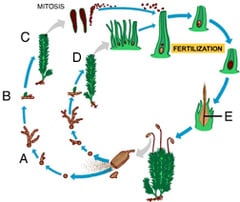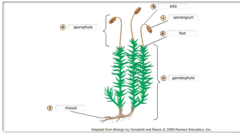Angiosperms are most closely related to _____.
a. gymnosperms
b. bryophytes
c. green algae
d. seedless vascular plants
e. charophyceans
gymnosperms
Which of these was the dominant plant group at the time that dinosaurs were the dominant animals?
a. bryophytes
b. charophyceans
c. angiosperms
d. gymnosperms
e. seedless vascular plants
gymnosperms
This is an image of a(n) _____.
a. seedless vascular plant
b. angiosperm
c. gymnosperm
d. bryophyte
e. charophycean
charophycean
Plants evolved from green algae approximately _____ million years ago.
a. 475
b. 400
c. 2,200
d. 3,500
e. 130
475
_____ are an example of seedless vascular plants.
a. Pine trees
b. Lilacs
c. Ferns
d. Charophyceans
e. Mosses
Ferns
The living plants that are most similar to the first plants to bear gametangia are the _____.
a. bryophytes
b. angiosperms
c. charophyceans
d. seedless vascular plants
e. gymnosperms
bryophytes
Which of these characteristics is shared by algae and seed plants?
a. roots and shoots
b. embryo development within gametangia
c. vascular tissue
d. pollen
e. chloroplasts
chloroplasts
Which of these represents the sporophyte generation of the moss life cycle?
a. D
b. A
c. E
d. C
e. B
E
In moss, _____ produce sperm.
a. embryos
b. antheridia
c. archegonia
d. protonemata
e. sporangia
antheridia
The sperm produced by mosses require _____ to reach an archegonium.
a. animals
b. the development of a flower
c. moisture
d. light
e. wind
moisture
In the moss life cycle _____ cells within a sporangium undergo _____ to produce _____ spores.
a. haploid … mitosis … haploid
b. haploid … meiosis … haploid
c. diploid … meiosis … haploid
d. diploid … mitosis … haploid
e. diploid … mitosis … diploid
diploid … meiosis … haploid
In mosses gametes are produced by _____; in ferns gametes are produced by _____
a. mitosis … mitosis
b. mitosis … meiosis
c. meiosis … mitosis
d. meiosis … meiosis
e. binary fission … mitosis
mitosis … mitosis
In mosses gametes are produced by _____; in ferns gametes are produced by _____.
a. mitosis … mitosis
b. meiosis … meiosis
c. binary fission … mitosis
d. meiosis … mitosis
e. mitosis … meiosis
mitosis … mitosis
Which of these structures is diploid?
a. D
b. B
c. C
d. A
e. E
D
Where do fern antheridia develop?
a. on the underside of the gametophyte
b. on the tip of the haploid protonema
c. on the tip of the gametophyte
d. on the underside of the sporophyte
e. on the tip of the sporophyte
on the underside of the gametophyte
The conspicuous part of a fern plant is a _____.
a. haploid sporophyte
b. diploid gametophyte
c. diploid sorus
d. haploid gametophyte
e. diploid sporophyte
diploid sporophyte
Which of these represents the sporophyte generation of the moss life cycle?
E
This is the young diploid sporophyte.
In moss, _____ produce sperm.
antheridia
The sperm produced by mosses require _____ to reach an archegonium.
moisture
In mosses gametes are produced by _____; in ferns gametes are produced by _____.
mitosis…mitosis
In both, gametes are produced by haploid gametophytes.
Which of these structures is diploid?
D
Where do fern antheridia develop?
on the underside of the gametophyte
The conspicuous part of a fern plant is a _____.
diploid sporophyte
Label the structures on this diagram of a moss.
Arrange the events in the life cycle of mosses in the flowchart below.
Angiosperms are most closely related to _____.
gymnosperms
Which of these was the dominant plant group at the time that dinosaurs were the dominant animals?
gymnosperms
Charophyceans are the green algae most closely related to plants
true
Plants evolved from green algae approximately _____ million years ago.
475
_____ are an example of seedless vascular plants.
ferns
The living plants that are most similar to the first plants to bear gametangia are the _____.
bryophytes
Which of these characteristics is shared by algae and seed plants?
chloroplasts
Let us know if this was helpful. That’s the only way we can improve.







